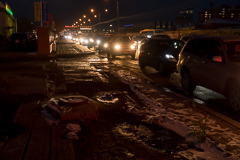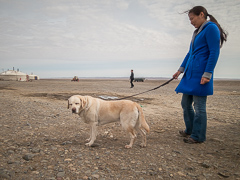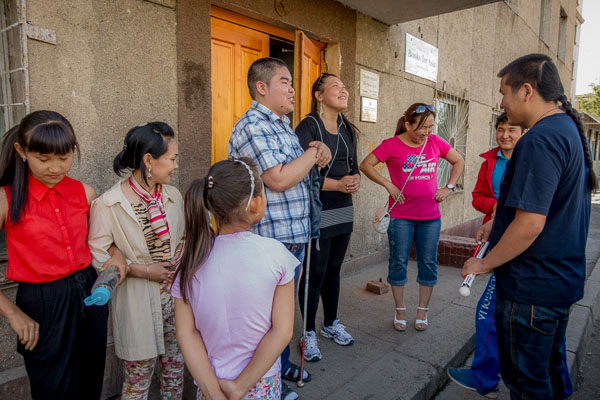Where The Blind Lead the Blind

Ulaanbaatar Sidewalk at Night
Every Saturday morning at ten this group, as many as a dozen or more, of blind or visually impaired Mongolians meets here for conversation, much of it in English, in an attempt to improve their skill with our language. Last year Judy joined this group on most Saturday mornings, and I came occasionally just to be a part of their conversation or to talk about things they were interested in. (It was not the first time I had taught photography to the blind.) With Judy in Darkhan this year, I meant to come visit once I got settled, but a chance meeting with some of the group members one evening propelled me from good intentions to making the commitment. Yes, they were still meeting on Saturdays, Angorik told me. Yes, at ten. Yes, come and see us.
Ok. Yes, I will be there.
Like other groups in Mongolia, this one is eager to meet native English speakers. Although English is a required second language in secondary school for all Mongolian students, it is taught with varying degrees of enthusiasm and proficiency, so it's quite easy for some to avoid becoming fluent. Those with visual impairment have a heightened need for fluency, since a significant part of their information about the outside world comes to them from the internet by way of screen readers, software that vocalizes text beneath the cursor on a computer screen. Most screen readers, like so much else that is related to technology, understand and read screens that are written in English. And to make it efficient to whiz through the pop-ups and tool-tips and dialog boxes, screen readers read very fast.
Group members range from a middle-aged English teacher all the way to, today, a sixth grader. Their impairment ranges in severity from just very poor eyesight to profound vision loss from birth, with many steps between. They navigate with canes when they need to, or from spatial memory in familiar locations like this library room, where even those who are totally blind will take my trash to a waste basket that is, I noted, a third of the way along the north wall of this room. In this tightly knit community, they also, literally, lead themselves, those with marginal vision walking arm-in-arm with those without.
Over the course of the past year I have come to understand another sense in which these group members are leading themselves, in the non-literal sense, the way we describe leaders in business or government or science. They each have their own interests, but by necessity and circumstance they are drawn to solving the peculiar problems that confront them. Angorik, whose English is the most proficient and whose blindness is among the most profound, is the de-facto leader of the group. Both in English and Mongolian, he has the social skills to draw out conversation from the timid or reluctant. Oyun Bayar, who plays the khuuchur, a two stringed bowed instrument, is by day the librarian in the Daisy Reading Room's braille collection, finding her way around with dexterity and keeping things perfectly organized. Tsaagii, (from tsaagan, or white) a Mongolian albino, manages an enterprise that is the equivalent of our Association for the Blind, where they are raising money by producing gers (Mongolian traditional housing) as well as printed packaging for retailers. Delguur Bayar, who is teaching computer science, is also working on a new screen reader, this one for Mongolians, that will read screens written in Mongolian.
In this group, I do not for a minute forget the fact that I can see. But because of the conversation that I've been privy to, it seems that they have forgotten that I am not blind, that they are sharing something that I really shouldn't be part of. Like blind jokes.
Q: What does the blind soldier say to his enemy?
A: Hello! Where are you, enemy?

Gladys and Oyunga
This week I asked about the Braille boards that two people had brought to take notes with. I learned that there are six possible dot positions for each character, and that the characters are formed by punching a stylus into a frame that contains a template for each character position, each with the six possible indentations for dots positioned underneath. Stiff paper goes between the rectangular character frame and the dot template underneath. Then, working backwards (so that the final result can be read left to right) the characters are punched into the paper. There is English Braille, and there is Mongolian Braille, and like we were told about the difference between Mongolian cyrillic and Russian cyrillic, you just know it when you see it—or feel it.
Although there is nothing like the Americans with Disabilities Act in Mongolia, we have met Mongolians who are trying to improve a situation that can only be described as dismal for those with disabilities, and not just for the blind. A long tradition of stepping over a threshold to enter a ger has made it seem normal to provide a barrier—between rooms, halfway down a hall, at the exit to a baggage claim at older airports—for luggage with wheels, people in wheelchairs, or those whose vision cannot alert them to the unexpected obstacles. Even more hazardous is the simple act of navigating sidewalks here, with broken pavement, piles of garbage, or what could be just described as a lack of continuity. For the blind, they are an obstacle course, as they are for those of us with good vision. One woman who occasionally comes to the library group attributes her blindness to a spinal cord injury that came from falling, at night, into a manhole whose cover was missing—a common occurrence here where they are sold for scrap.
